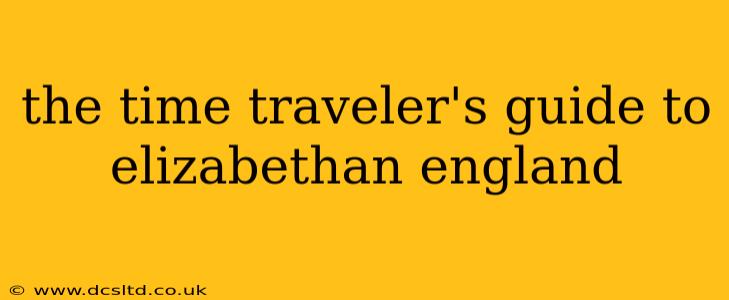Welcome, time traveler! You're about to embark on a fascinating journey to Elizabethan England, a period brimming with intrigue, innovation, and a vibrant culture that continues to captivate us centuries later. This guide will equip you with the essential knowledge to navigate this era safely and effectively, ensuring your trip is both enriching and memorable. Forget the romanticized notions often portrayed in popular culture; we'll delve into the realities of life in 16th-century England.
What Was Daily Life Like in Elizabethan England?
Daily life in Elizabethan England varied drastically depending on social class. For the wealthy, life revolved around courtly life, lavish feasts, and political maneuvering. However, for the vast majority – the peasants and laborers – life was a constant struggle for survival. Their days were filled with backbreaking toil in the fields, punctuated by religious observance and community events. Hygiene standards were far lower than today's, and disease was a constant threat. The average lifespan was significantly shorter than it is now.
What Were the Biggest Differences Between Elizabethan England and Modern Life?
The differences between Elizabethan England and modern life are profound. Consider these key distinctions:
- Technology: Imagine a world without electricity, automobiles, or even running water. Communication relied on messengers and letters, travel was slow and arduous, and information spread slowly.
- Medicine: Medical practices were rudimentary, and many common ailments were deadly. Herbal remedies and bloodletting were common treatments.
- Social Structure: Society was rigidly hierarchical, with the monarch at the apex and peasants at the base. Social mobility was extremely limited.
- Religion: Religious tensions were high, with the recent shift to Protestantism still causing unrest and persecution.
- Entertainment: Entertainment was largely communal, with popular pastimes including bear-baiting, public executions, and theatrical performances.
What Were the Major Social Classes in Elizabethan England?
Elizabethan England's social structure was highly stratified:
- The Monarch: Queen Elizabeth I held ultimate power and authority.
- The Nobility: Wealthy landowners with significant political influence.
- The Gentry: Landowners of lesser wealth but still considerable status.
- The Merchants and Craftsmen: The burgeoning middle class, increasingly influential in urban areas.
- The Yeomanry: Independent farmers who owned their own land.
- The Laborers and Peasants: The majority of the population, working the land for wages or as serfs.
What Was the Role of Women in Elizabethan England?
Women's roles in Elizabethan England were largely defined by their social class. Aristocratic women enjoyed more freedom and influence than their lower-class counterparts. However, all women faced societal expectations that limited their opportunities. Marriage was often the primary path to social and economic security, and women's lives largely revolved around domestic duties and child-rearing.
What Were the Most Common Diseases in Elizabethan England?
The plague (bubonic plague), typhoid fever, dysentery, and smallpox were common and deadly diseases. Lack of sanitation and understanding of disease transmission contributed to their prevalence.
How Did People in Elizabethan England Communicate?
Communication relied heavily on face-to-face interactions, messengers, and letters. The printing press, while present, hadn't yet revolutionized information dissemination to the extent it would later.
What Were the Most Popular Forms of Entertainment in Elizabethan England?
Popular forms of entertainment included:
- Theatre: Shakespeare's plays thrived during this era.
- Bear-baiting and other blood sports: These were extremely popular, reflecting the time's more brutal sensibilities.
- Music and dancing: Music played a significant role in social gatherings.
- Feasts and celebrations: These were frequent occasions for social interaction.
Conclusion: Preparing for Your Journey
This guide has only scratched the surface of the complexities of Elizabethan England. Remember, careful preparation is crucial. Understanding the social structures, customs, and potential dangers will greatly enhance your experience and ensure your safe return. Embrace the opportunity to learn about this fascinating period, and may your journey be filled with enlightening discoveries!
